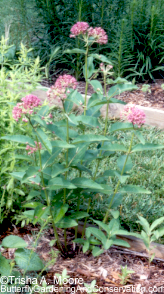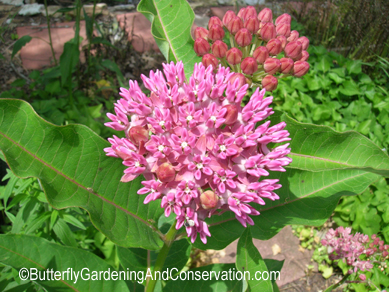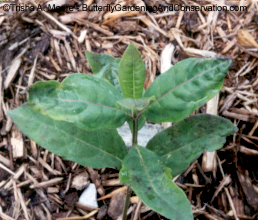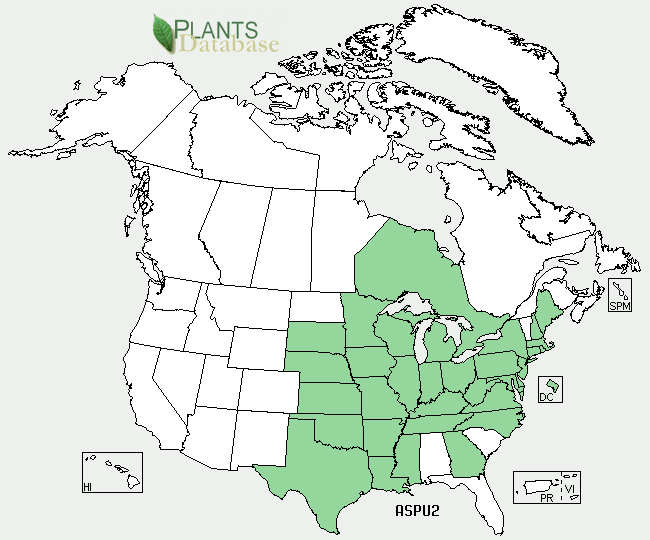|
 Purple Milkweed (Asclepias purpurascens) is a beautiful member of the milkweed family. It can grow up to three
feet tall with leaves that are broad and thick compared to
butterfly weed and
tropical milkweed.
Purple Milkweed blooms early
in the spring with flowers that are in general a bit more showy than some species of milkweed.
The flowers are a deep purple/magenta like color that is very beautiful.
Purple Milkweed (Asclepias purpurascens) is a beautiful member of the milkweed family. It can grow up to three
feet tall with leaves that are broad and thick compared to
butterfly weed and
tropical milkweed.
Purple Milkweed blooms early
in the spring with flowers that are in general a bit more showy than some species of milkweed.
The flowers are a deep purple/magenta like color that is very beautiful.
In general, milkweeds contain cardiac glycosides and resinoids which are poisonous, although for people quite a bit
would need to be ingested. The cardiac glycosides interfere with cell membrane sodium/potassium pumps.
Cardiac glycosides are also used to treat congestive heart failure and cardiac arrhythmia.
It can take three or more years for a new seedling to bloom.
Purple Milkweed is a Host Plant for
Monarch Butterflies
Purple Milkweed, like other milkweeds, are host plants for
Monarch butterflies.
Monarchs
in my area will lay eggs on it, especially early in the season when some of the
other milkweeds have not come back up yet.
The poisons in the milkweed plants do not bother
Monarchs.
Instead they make them taste bad to potential
predators.
More Purple Milkweed Pictures
Here is a close up of the blooms:

The following picture shows a small, young plant:

Where to buy Purple Milkweed
Typical nurseries don't usually sell this plant. You will most likely have to find a native plant nursery.
Growing Tips
My experience with this plant has been very good. However, the ones I grew from seed looked terrible the first couple
years I had them. I didn't think they would survive. They start out growing pretty slow.
If I wanted to get more I would probably buy the plant rather than to start from seed.
New seedlings may not bloom for the first few years after germinating. And once mine
started blooming the seed pods were not healthy or producing a significant amount of seed either.
Even though I've read that purple milkweed doesn't spread, I think that it does or can a little bit.
Not enough to be considered invasive though.
|
Current status of this plant in my garden (last updated: 3/09)
|
I'm not sure how many purple milkweeds I have growing, not a whole lot though.
But I love them because the flowers are so pretty and they provide a place for
Monarchs
to lay eggs before the other milkweeds are growing.
I've found eggs on them in the spring when the stems are just barely sticking out of the ground.
Since the leaves are pretty thick I don't think Monarchs like them as well as
Swamp Milkweed (Asclepias incarnata)
and
Tropical Milkweed (Asclepias curassavica),
but will use them, especially early in the season.
|
The Asclepiadaceae Family
This family has about 250 genera and roughly 2000 species. Mostly tropical and subtropical. Some species are herbs, others
are vines and shrubs. Most have a milky sap containing poisons (see above).
Distribution
From the U. S. Department of Agriculture:

Classification
| Kingdom: | Plantae – Plants |
| Subkingdom: | Tracheobionta – Vascular plants |
| Superdivision: | Spermatophyta – Seed plants |
| Division: | Magnoliophyta – Flowering plants |
| Class: | Magnoliopsida – Dicotyledons |
| Subclass: | Asteridae |
| Order: | Gentianales |
| Family: | Asclepiadaceae – Milkweed family |
| Genus: | Asclepias L. – milkweed |
| Species: | Asclepias purpurascens L. – purple milkweed |
Butterfly Gardening Home |
Butterfly Gardening Articles |
Butterfly Species |
Plants |
Butterfly and Gardening Shopping |
T-shirts |
Mugs |
Magnets |
Clocks |
Tote Bags |
Framed Tiles |
Notebooks |
Postcards |
Light Switch Covers |
Tile Coasters |
Calendars |
Butterfly Calendars |
Resources |
Contact |
Blog |
[old blog] |
© 2003 - 2025 ButterflyGardeningAndConservation.com
Today is: 18 April 2025, 7:09 am |

